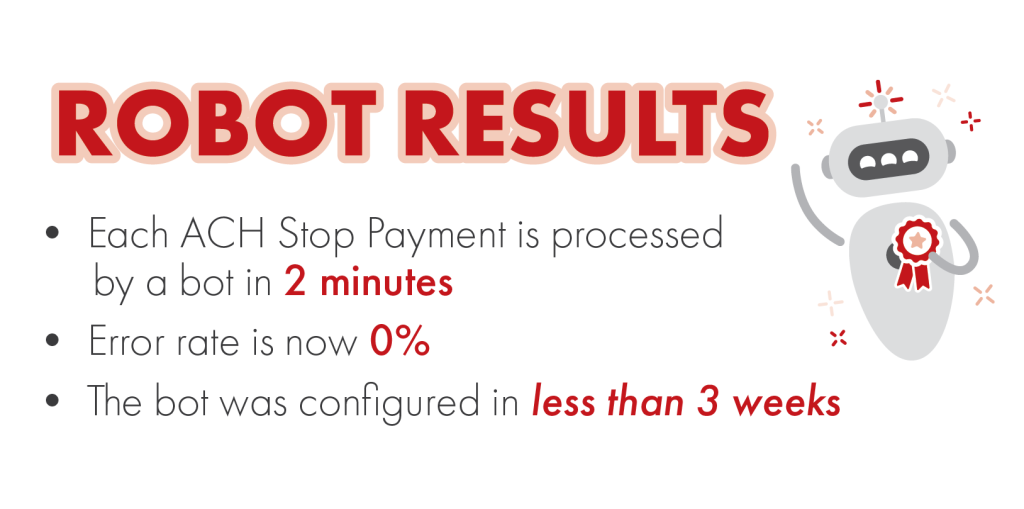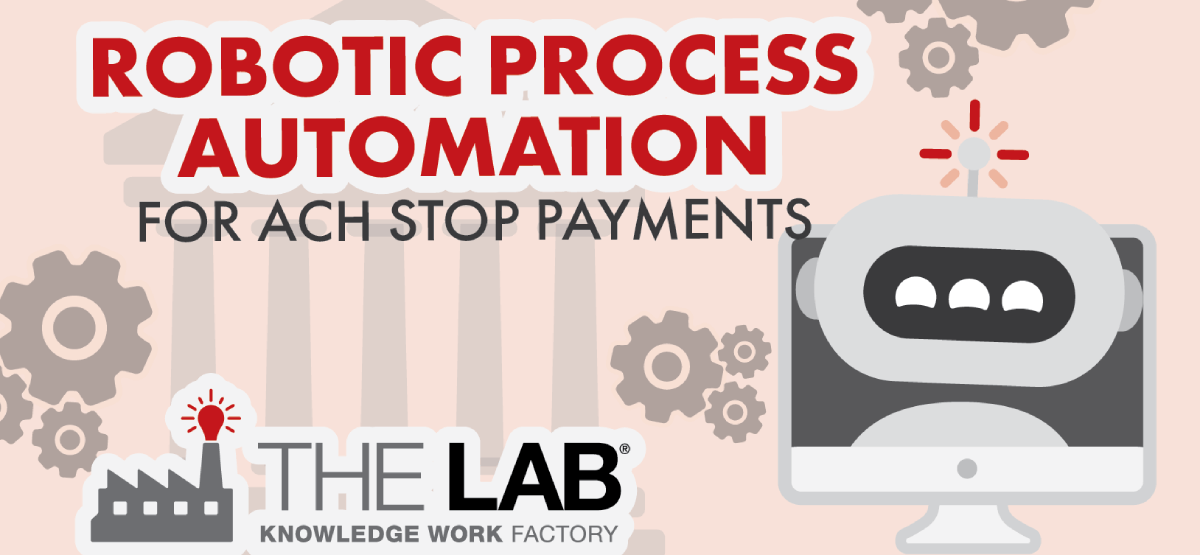Speed operations, eliminate drudge work and errors, and save 500 to 7,000 hours in your bank or credit union with robotic process automation
Stop-payments are a common transaction between all banks. Despite the “automated” part of Automated Clearing House (ACH), these are processed manually by banks every day, totaling thousands in a short time.
In this article, The Lab will show how stop-payment requests are routinely processed at banks today—including the different “flavors” thereof. Then we’ll show how easy it is for us to automate this laborious, error-prone, manual activity… with robots. This article is a companion to this video which shows the actual robot in action, with sensitive data blurred for privacy.
Different banks, similar systems, different ways to stop payments
The Lab has automated stop-payment processing for different banks. And guess what? The processes were all different. Some banks use more steps, and more systems, than others. Bear that in mind as you read this article, since your bank’s ACH stop-payment process may differ slightly from what’s described here.
The important takeaway: The Lab can automate any method of stop-payment processing.
(It almost goes without saying that The Lab can automate tons of other routine banking activities, too.)
ACH Stop-payment robotic process automation in the spotlight
At this bank, a person must undertake six discrete steps in order to process a single stop-payment request:
- First, they must access a network drive, and search it for a stop-payment spreadsheet.
- Then, they must filter, sort, and prioritize the different stop-payments in Excel.
- Next, they log into the first core system—FIS Insight—to process the stop-payments, and update each account.
- After that, they match the payee’s name against the spreadsheet data, and take a screen-shot of it, for proof. (Different banks have different ways of “papering the audit trail.”)
- Next, they log into another system—FIS Exception—and process the transaction… or rather try to. This network connection often times out. So they sit there and wait… and try again… and again… until they finally get through. Talk about a time-waster.
- Finally—once they get into the system—they process the overdrawn payment.
That’s a lot of steps for one stop-payment! But it’s not a lot of vendors. Note that two of the systems—Insight and Exception—are both made by the same company: FIS. But neither system talks to the other. This is what necessitates the “human glue”—in the form of a highly-paid knowledge worker.
Send in the banking RPA bots
If you’ve ever seen an Excel macro in action, you can understand and appreciate what a “robot” is. It’s just a little piece of software that can “sit at a computer” and do everything a person does, across lots of different systems. It can click, type, copy, paste, and so on.
For this bank, the robot which The Lab configured does all the same steps. It brings up the spreadsheet from the shared drive. It navigates to the web-based FIS Insight platform, where it logs in with its own user ID and password, just like a person. Then it flies through all the other steps we’d described above, clicking, copying, and pasting with inhuman speed.
But what about that connection which often times out? What does the robot do? Does it crash?
Not at all. The Lab simply programmed it to do what a person would do. It sits. Patiently. And waits. And then it tries again. And again. Until it gets through.
So the bot does everything a person did. It even takes the screen shot, names it, and files it in the right place as proof of the transaction.

But there’s one big difference. A human takes about 13 minutes to process a single stop payment (and remember: they’ll do dozens of them in a day). The human worker also generates a ten-percent error rate.
The robot, on the other hand, does the same work in just two minutes. And its error rate is zero.
Banking and credit union executives are turning to The Lab to accelerate automation/AI readiness, lay the groundwork for strategic end-to-end process/product innovation, and implement Robotic Process Automation (RPA) “bots” to automate dozens of processes. With as few as three RPA bots from The Lab, you, too, can begin implementing on your company-wide strategic innovation roadmap—and start seeing hard-dollar benefits within weeks.
The best way to appreciate the speed and game-changing power of the automation suites installed by The Lab is to see it for yourself. Schedule a free, no-obligation 30-minute screen-sharing demo with The Lab, and you’ll see RPA bots in action. You’ll learn how we do all this from our U.S. offices in Houston, with nothing outsourced or offshored, and get all your questions answered by our friendly experts. Hedge your company against employee turnover, eliminate errors, and put your organization on a roadmap to accelerate your automation and AI initiatives.
Simply call (201) 526-1200 or email info@thelabconsulting.com to book your demo today!
















